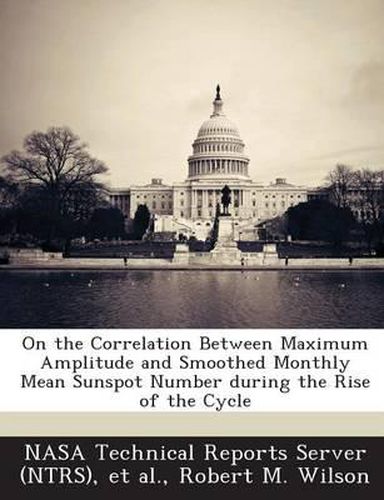Readings Newsletter
Become a Readings Member to make your shopping experience even easier.
Sign in or sign up for free!
You’re not far away from qualifying for FREE standard shipping within Australia
You’ve qualified for FREE standard shipping within Australia
The cart is loading…






During the rise from sunspot minimum to maximum, the observed value of smoothed monthly mean sunspot number at maximum RM is found to correlate with increasing strength against the current value of smoothed monthly mean sunspot number R(t), where t is the elapsed time in months from minimum. On the basis of the modern era sunspot cycles (i.e., cycles 10-22), the inferred linear correlation is found to be statistically important (i.e., at the 95-percent level of confidence) from about 11 mo past minimum and statistically very important (i.e.. at the 99-percent level of confidence) from about 15 mo past minimum; ignoring cycle 19, the largest cycle of the modern era, the inferred linear correlation is found to be statistically important from cycle onset. On the basis of R(t), estimates of RM can be gauged usually to within about +/- 30 percent during the first 2 yr and to within about +/- 20 percent (or better) after the first 2 yr of a cycle’s onset. For cycle 23, because controversy exists regarding the placement of its minimum (i.e., its onset), being either May 1996 or perhaps August 1996 (or shortly thereafter), estimates of its RM are divergent, being lower (more like a mean size cycle) when using the earlier epoch of minimum and higher (above average in size) when using the later-occurring minimum. For smoothed monthly mean sunspot number through October 1997 (t = 17 or 14 mo, respectively), having a provisional value of 32.0. the earlier minimum date projects an RM of 110.3 +/- 33.1, while the later minimum date projects one of 137.2 +/- 41.2. The projection is slowly decreasing in size using the earlier onset date, while it is slowly increasing in size using the later onset date.
$9.00 standard shipping within Australia
FREE standard shipping within Australia for orders over $100.00
Express & International shipping calculated at checkout
During the rise from sunspot minimum to maximum, the observed value of smoothed monthly mean sunspot number at maximum RM is found to correlate with increasing strength against the current value of smoothed monthly mean sunspot number R(t), where t is the elapsed time in months from minimum. On the basis of the modern era sunspot cycles (i.e., cycles 10-22), the inferred linear correlation is found to be statistically important (i.e., at the 95-percent level of confidence) from about 11 mo past minimum and statistically very important (i.e.. at the 99-percent level of confidence) from about 15 mo past minimum; ignoring cycle 19, the largest cycle of the modern era, the inferred linear correlation is found to be statistically important from cycle onset. On the basis of R(t), estimates of RM can be gauged usually to within about +/- 30 percent during the first 2 yr and to within about +/- 20 percent (or better) after the first 2 yr of a cycle’s onset. For cycle 23, because controversy exists regarding the placement of its minimum (i.e., its onset), being either May 1996 or perhaps August 1996 (or shortly thereafter), estimates of its RM are divergent, being lower (more like a mean size cycle) when using the earlier epoch of minimum and higher (above average in size) when using the later-occurring minimum. For smoothed monthly mean sunspot number through October 1997 (t = 17 or 14 mo, respectively), having a provisional value of 32.0. the earlier minimum date projects an RM of 110.3 +/- 33.1, while the later minimum date projects one of 137.2 +/- 41.2. The projection is slowly decreasing in size using the earlier onset date, while it is slowly increasing in size using the later onset date.